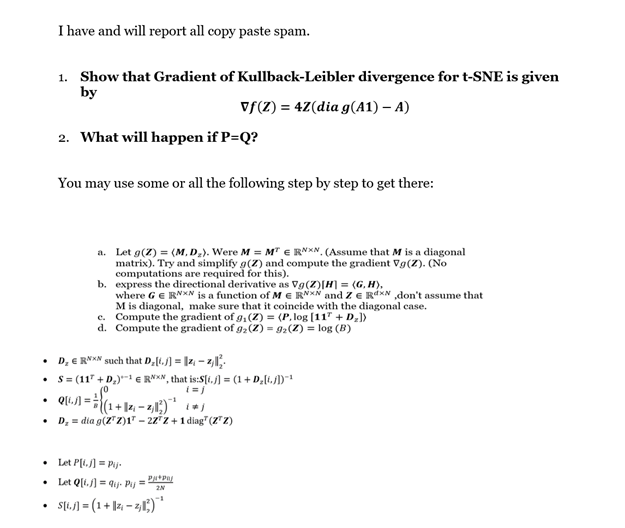Answered step by step
Verified Expert Solution
Question
1 Approved Answer
. . . I have and will report all copy paste spam. 1. Show that Gradient of Kullback-Leibler divergence for t-SNE is given by

. . . I have and will report all copy paste spam. 1. Show that Gradient of Kullback-Leibler divergence for t-SNE is given by vf (Z) = 4Z(dia g(A1) - A) . 2. What will happen if P=Q? You may use some or all the following step by step to get there: a. Let g(Z) = (M, D). Were M = MT E RNXN. (Assume that M is a diagonal matrix). Try and simplify g(Z) and compute the gradient Vg(Z). (No computations are required for this). Q[L]== b. express the directional derivative as Vg(Z)[H] = (G, H), where GERNXN is a function of M E RNXN and Z E Rdx ,don't assume that M is diagonal, make sure that it coincide with the diagonal case. Compute the gradient of g, (Z) = (P.log [11 + D]) Compute the gradient of 92 (Z) = 9(Z) = log (B) c. d. D R*** such that D[j] = |zz| S=(117+D) RN, that is:S[./] = (1 + D[/])- (0 (=/ 1 = = {(1 + 12 - 21/1) + (~) -1 D = dia g(ZZ)1-2ZZ+ 1 diag (ZZ) Let P[i,j] = Pij- Pu+Paj Let Q[i,j] = Qij-Pij=' 2N S[t.j] = (1+z-2
Step by Step Solution
There are 3 Steps involved in it
Step: 1
Here are the steps to show that the gradient of KullbackLeibler divergence for tSNE is given ...
Get Instant Access to Expert-Tailored Solutions
See step-by-step solutions with expert insights and AI powered tools for academic success
Step: 2

Step: 3

Ace Your Homework with AI
Get the answers you need in no time with our AI-driven, step-by-step assistance
Get Started


